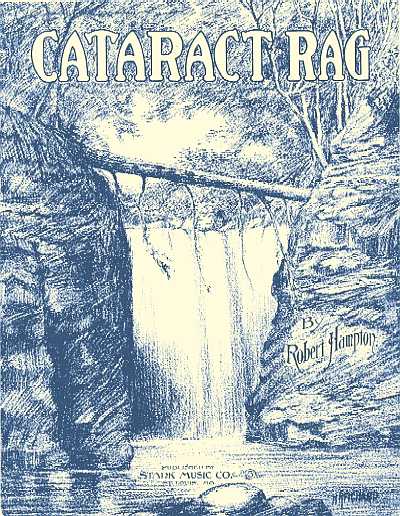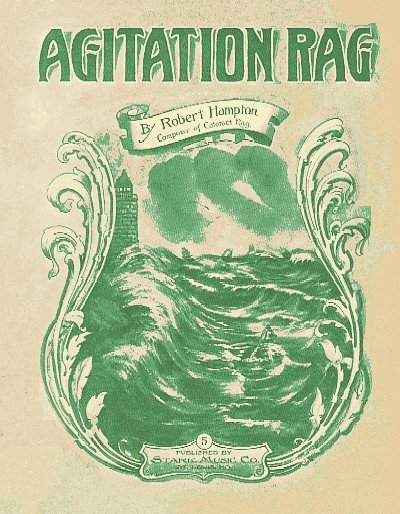 Robert William Hampton (August 10?, 1890 to September 25, 1945) | |
 Compositions Compositions | |
|
The Dogin' Rag (c. 1913)
Cataract Rag (1914) |
Agitation Rag (1915)
|
Robert Hampton was born in Tuscumbia, Alabama to William Hampton and Annie Maddox. He was known to have spent most of the ragtime era and many years after in St. Louis, Missouri after many years in his youth in the Little Rock, Arkansas area. The 1900 census listed him as living in Little Rock, Arkansas, with his widowed mother Annie and his older brother William "Willie" (11/1886), who had been born in Georgia. The birth date on the 1900 enumeration is in question at variance with his official date listed on his WWI draft card, showing September of 1890 in the census and July 25, 1891 for the draft. For the record, his California death certificate splits the difference, showing a birth date of August 10, 1890, so that will be accepted as potentially the most accurate for this essay. Hampton's tombstone shows an August 10, 1891 date. It is possible that he simply was not entirely sure of his actual birth date.
showing a birth date of August 10, 1890, so that will be accepted as potentially the most accurate for this essay. Hampton's tombstone shows an August 10, 1891 date. It is possible that he simply was not entirely sure of his actual birth date.
 showing a birth date of August 10, 1890, so that will be accepted as potentially the most accurate for this essay. Hampton's tombstone shows an August 10, 1891 date. It is possible that he simply was not entirely sure of his actual birth date.
showing a birth date of August 10, 1890, so that will be accepted as potentially the most accurate for this essay. Hampton's tombstone shows an August 10, 1891 date. It is possible that he simply was not entirely sure of his actual birth date.Hampton was next shown living in St. Louis, Missouri, in 1910 with his mother and Willie, now listed as a musician at 19 years old. His reputation would grow quickly over the next few years, and Robert was known by some to be a masterful performer. He was also an influence to many of the St. Louis school of ragtime artists, including Artie Matthews, Charlie Thompson and Charles Hubbard. Even Ferdinand "Jelly Roll" Morton potentially recalled Hampton (he referred to a Bob Hamilton, but no musician Bob Hamilton was known in St. Louis) as an inspiration to him, and perhaps even a bit of a threat within Morton's subtext according to some stories.
Three existing rags, The Dogin' Rag (which included some lyrics), Cataract Rag and Agitation Rag, represent his published output, although he reportedly had at least forty other pieces to his name. Cataract and Agitation made it into print through the help of Artie Matthews, who at the time was a staff arranger for John Stark in St. Louis. Many consider the Cataract Rag to be somewhat classical in nature, given its descriptive arpeggiated passages simulating the waterfalls indicated in the title. Agitation Rag came out sounding much more like one of Matthew's Pastime Rags, yet the final section is a singular marvel in ragtime musical literature with its beautiful cohesively shifting chords, all of them skipping the main beats of each measure. These two rags are still performed frequently a century later.
yet the final section is a singular marvel in ragtime musical literature with its beautiful cohesively shifting chords, all of them skipping the main beats of each measure. These two rags are still performed frequently a century later.
 yet the final section is a singular marvel in ragtime musical literature with its beautiful cohesively shifting chords, all of them skipping the main beats of each measure. These two rags are still performed frequently a century later.
yet the final section is a singular marvel in ragtime musical literature with its beautiful cohesively shifting chords, all of them skipping the main beats of each measure. These two rags are still performed frequently a century later.In 1917 Hampton was living in St. Louis with a wife and possibly his mother, although the information on his draft card is incomplete in this regard, simply showing himself as married as well as his mother's sole source of support. He was employed by a Fred Fryer or Fizer, commuting across the river into Madison County, Illinois for his work. It appears that he "married" or was at least residing with Mississippi native Willa B. Williams, who would have been just shy of 14 to his 26 when the first draft was taken. During World War I Robert served in the army, achieving the rank of Corporal, according to his 1945 burial record. After the war, Willa died of pneumonia on February 13, 1919, in Saint Louis, shown as barely 15, but still married. For the 1920 enumeration Robert was shown living very near his mother and brother, still in St. Louis, employed as a musician in a café, and his marital status now read as widowed.
In his later years, Robert was unable to play with the same dexterity and scope that he had during the 1910s. Having become less highly regarded for his musicianship in St. Louis, a city which had been largely abandoned by ragtime players and composers following the 1904 Lewis and Clark Exposition, Hampton was reportedly bitter about his plight, particularly about how his music in particular had been forgotten or largely dismissed. He moved to Los Angeles, California at some point during the 1920s. Hampton was listed in Los Angeles as an orchestra musician in the 1930 census, although if this was steady employment for him is unknown. He was rooming with Mrs. Josephine Brown and her daughter Thelma Valentine, both Louisiana natives. Hampton was shown working as a musician and living in West Hollywood as late as 1937 in the city directories.
Robert Hampton lived out the rest of his life in Southern California, dying there at around 55 years of age, just a few years short of the ragtime revival for which a few of his contemporaries would still be around to enjoy. He is buried at the Jefferson Barracks National Cemetery near Saint Louis.